

Compact Muon Solenoid
LHC, CERN
| CMS-BPH-21-001 ; CERN-EP-2022-248 | ||
| Measurement of the dependence of the hadron production fraction ratio $ f_\mathrm{s}/f_\mathrm{u} $ on B meson kinematic variables in proton-proton collisions at $ \sqrt{s} = $ 13 TeV | ||
| CMS Collaboration | ||
| 5 December 2022 | ||
| Phys. Rev. Lett. 131 (2023) 121901 | ||
| Abstract: The dependence of the ratio between the $ \mathrm{B}_{\mathrm{s}}^{0} $ and $ {\mathrm{B}^{+}} $ hadron production fractions, $ f_\mathrm{s}/f_\mathrm{u} $, on the transverse momentum ($ p_{\mathrm{T}} $) and rapidity of the B mesons is studied using the decay channels $ \mathrm{B}_{\mathrm{s}}^{0} \! \to \! \mathrm{J}/\psi \, \phi $ and $ {\mathrm{B}^{+}} \! \to \! \mathrm{J}/\psi \, \mathrm{K}^{+} $. The analysis uses a data sample of proton-proton collisions at a center-of-mass energy of 13 TeV, collected by the CMS experiment in 2018 and corresponding to an integrated luminosity of 61.6 fb$ ^{-1} $. The $ f_\mathrm{s}/f_\mathrm{u} $ ratio is observed to depend on the B $ p_{\mathrm{T}} $ and to be consistent with becoming asymptotically constant at large $ p_{\mathrm{T}} $. No rapidity dependence is observed. The ratio of the $ {\mathrm{B}^0} $ to $ {\mathrm{B}^{+}} $ hadron production fractions, $ f_\mathrm{d}/f_\mathrm{u} $, measured using the $ {\mathrm{B}^0} \! \to \! \mathrm{J}/\psi \, \mathrm{K^{\ast}(892)}^{0} $ decay channel, is found to be consistent with unity and independent of $ p_{\mathrm{T}} $ and rapidity. | ||
| Links: e-print arXiv:2212.02309 [hep-ex] (PDF) ; CDS record ; inSPIRE record ; HepData record ; CADI line (restricted) ; | ||
| Figures | |

png pdf |
Figure 1:
The $ \mathrm{J}/\psi \, \phi $, $ \mathrm{J}/\psi \, \mathrm{K^+} $, and $ \mathrm{J}/\psi \, \mathrm{K^{\ast}(892)}^{0} $ invariant mass distributions for B meson candidates with 20 $ < p_{\mathrm{T}} < $ 23 GeV, and associated fits as described in the text. |

png pdf |
Figure 2:
Efficiency-corrected yield ratio $ {\mathcal R_\mathrm{s}} $, as a function of $ p_{\mathrm{T}} $ (left) and $ |y| $ (right). The vertical bars (boxes) represent the statistical (bin-to-bin systematic) uncertainties, while the horizontal bars give the bin widths. The global uncertainty (of 2.3%) is not graphically represented. The blue line represents the average for $ p_{\mathrm{T}} > $ 18 GeV. For comparison, the LHCb measurement [14] is also shown. |
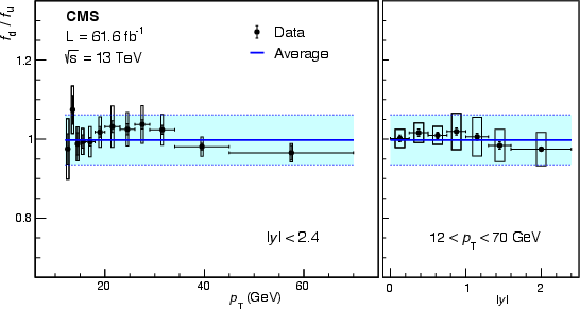
png pdf |
Figure 3:
The ratio of the $ {\mathrm{B}^0} $ to $ {\mathrm{B}^{+}} $ hadron production fractions $ f_\mathrm{d}/f_\mathrm{u} $, as a function of $ p_{\mathrm{T}} $ (left) and $ |y| $ (right). The vertical bars (boxes) represent the statistical (bin-to-bin systematic) uncertainties, while the horizontal bars give the bin widths. The global uncertainty (of 4.9%) is not graphically represented. The blue line represents the average of all the points. |
| Tables | |
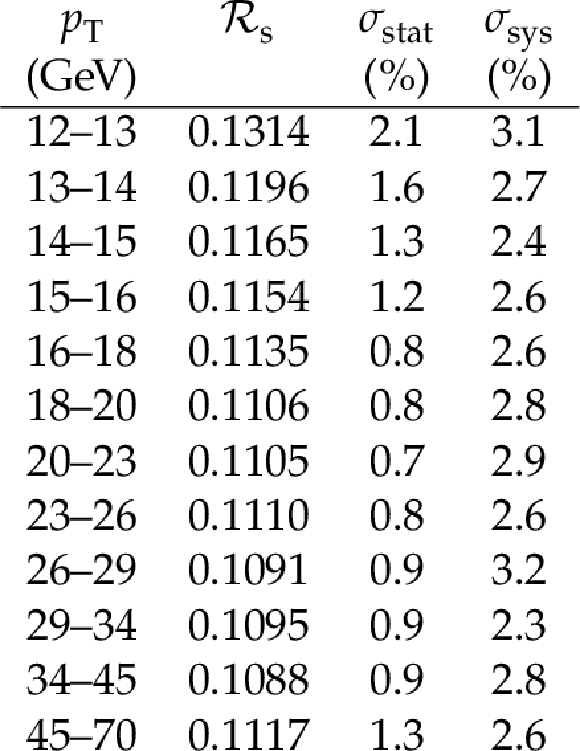
png pdf |
Table A1:
The measured $ {\mathcal R_\mathrm{s}} $ values as a function of $ p_{\mathrm{T}} $, with the statistical ($ \sigma_{\text{stat}} $) and bin-to-bin systematic ($ \sigma_{\text{sys}} $) uncertainties, in percent. All the results are also affected by an extra global systematic uncertainty of 2.3%, reflecting the track reconstruction efficiency. |
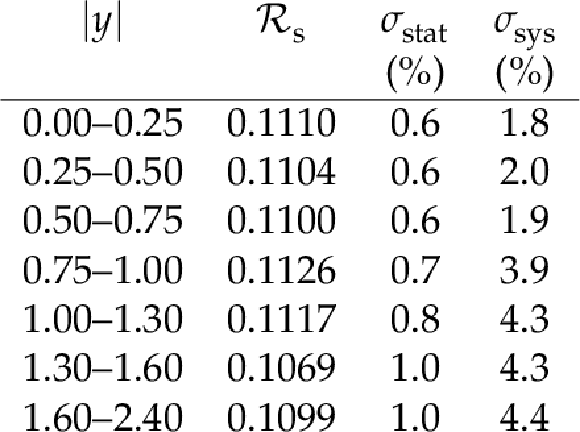
png pdf |
Table A2:
The measured $ {\mathcal R_\mathrm{s}} $ values as a function of $ |y| $, with the statistical ($ \sigma_{\text{stat}} $) and bin-to-bin systematic ($ \sigma_{\text{sys}} $) uncertainties, in percent. All the results are also affected by an extra global systematic uncertainty of 2.3%, reflecting the track reconstruction efficiency. |
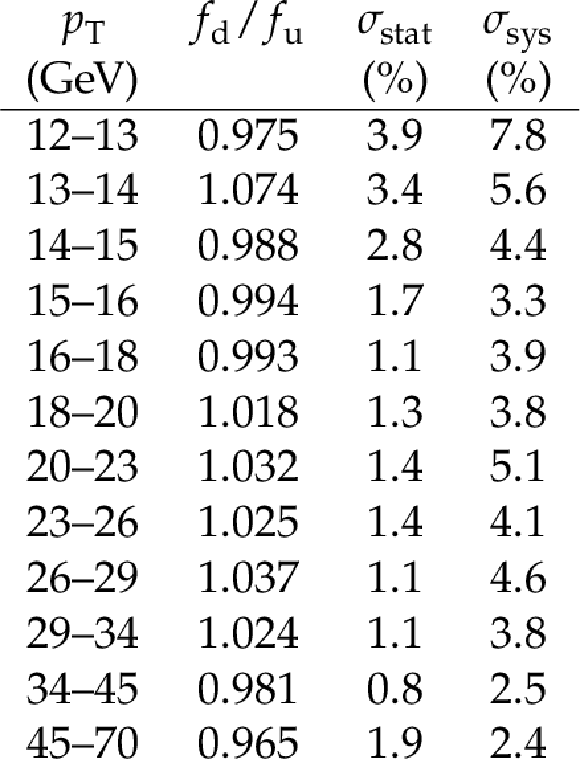
png pdf |
Table A3:
The measured $ f_\mathrm{d}/f_\mathrm{u} $ values as a function of $ p_{\mathrm{T}} $, with the statistical ($ \sigma_{\text{stat}} $) and bin-to-bin systematic ($ \sigma_{\text{sys}} $) uncertainties, in percent. All the results are also affected by an extra global systematic uncertainty of 4.9%, reflecting the track reconstruction efficiency and the branching fractions needed to convert $ {\mathcal R_\mathrm{d}} $ into $ f_\mathrm{d}/f_\mathrm{u} $. |
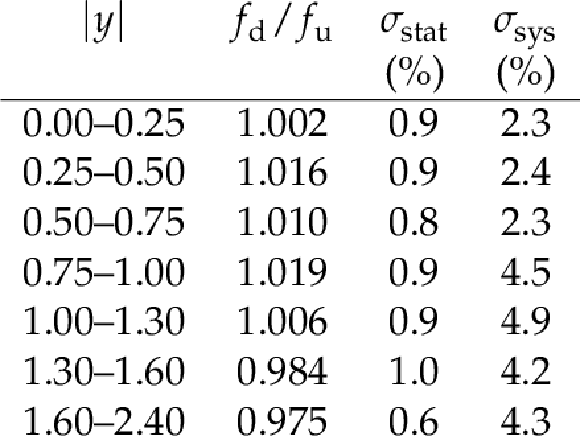
png pdf |
Table A4:
The measured $ f_\mathrm{d}/f_\mathrm{u} $ values as a function of $ |y| $, with the statistical ($ \sigma_{\text{stat}} $) and bin-to-bin systematic ($ \sigma_{\text{sys}} $) uncertainties, in percent. All the results are also affected by an extra global systematic uncertainty of 4.9%, reflecting the track reconstruction efficiency and the branching fractions needed to convert $ {\mathcal R_\mathrm{d}} $ into $ f_\mathrm{d}/f_\mathrm{u} $. |
| Summary |
| In summary, the ratio of the $ \mathrm{B}_{\mathrm{s}}^{0} $ and $ {\mathrm{B}^{+}} $ hadron production fractions, $ f_\mathrm{s}/f_\mathrm{u} $, directly proportional to the ratio of the efficiency-corrected meson yields, $ {\mathcal R_\mathrm{s}} $, is studied as a function of the B meson transverse momentum $ p_{\mathrm{T}} $ and rapidity, using the $ \mathrm{B}_{\mathrm{s}}^{0} \! \to \! \mathrm{J}/\psi \, \phi $ and $ {\mathrm{B}^{+}} \! \to \! \mathrm{J}/\psi \, \mathrm{K}^{+} $ decay channels. The analysis uses an event sample of pp collisions at a center-of-mass energy of 13 TeV, collected by CMS in 2018 and corresponding to an integrated luminosity of 61.6 fb$ ^{-1} $. While no $ {\mathcal R_\mathrm{s}} $ dependence on the B meson rapidity is seen, a strong variation is observed in the 12 $ < p_{\mathrm{T}} < $ 18 GeV range, followed by a flat trend for higher $ p_{\mathrm{T}} $ values. The $ f_\mathrm{d}/f_\mathrm{u} $ ratio, measured using the $ {\mathrm{B}^0} \! \to \! \mathrm{J}/\psi \, \mathrm{K^{\ast}(892)}^{0} $ decay channel, is found to be compatible with unity and independent of rapidity and $ p_{\mathrm{T}} $, as predicted by strong isospin symmetry. The b hadron production fractions presented in this Letter provide a crucial input to measurements by ATLAS and CMS of the $ \mathrm{B}_{\mathrm{s}}^{0} \to \mu^{+}\mu^{-} $ branching fraction. |
| References | ||||
| 1 | CMS and LHCb Collaborations | Observation of the rare $ \mathrm{B}_{s}^{0} \to \mu^{+}\mu^{-} $ decay from the combined analysis of CMS and LHCb data | Nature 522 (2015) 68 | 1411.4413 |
| 2 | ATLAS Collaboration | Study of the rare decays of $ \mathrm{B}_{s}^{0} $ and $ {\mathrm{B}^0} $ mesons into muon pairs using data collected during 2015 and 2016 with the ATLAS detector | JHEP 04 (2019) 098 | 1812.03017 |
| 3 | CMS Collaboration | Measurement of properties of $ \mathrm{B}_{s}^{0} \to \mu^{+}\mu^{-} $ decays and search for $ {\mathrm{B}^0} \to \mu^{+}\mu^{-} $ with the CMS experiment | JHEP 04 (2020) 188 | CMS-BPH-16-004 1910.12127 |
| 4 | LHCb Collaboration | Measurement of the $ \mathrm{B}_{s}^{0} \to \mu^{+}\mu^{-} $ branching fraction and effective lifetime and search for $ {\mathrm{B}^0} \to \mu^{+}\mu^{-} $ decays | PRL 118 (2017) 191801 | 1703.05747 |
| 5 | LHCb Collaboration | Measurement of the $ \mathrm{B}_{s}^{0} \to \mu^{+}\mu^{-} $ decay properties and search for the $ {\mathrm{B}^0} \to \mu^{+}\mu^{-} $ and $ \mathrm{B}_{s}^{0} \to \mu^{+}\mu^{-}\gamma $ decays | PRD 105 (2022) 012010 | 2108.09283 |
| 6 | OPAL Collaboration | Evidence for the existence of the strange b-flavoured meson $ \mathrm{B}_{s}^{0} $ in $ \mathrm{Z^0} $ decays | PLB 295 (1992) 357 | |
| 7 | ALEPH Collaboration | Measurement of the $ \mathrm{B}_{s}^{0} $ lifetime and production rate with $ \mathrm{D}_{s}^{-} \ell^+ $ combinations in Z decays | PLB 361 (1995) 221 | |
| 8 | L3 Collaboration | Measurements of the $ \mathrm{b}\overline{\mathrm{b}} $ production cross-section and forward backward asymmetry at center-of-mass energies above the Z pole at LEP | PLB 485 (2000) 71 | hep-ex/0005023 |
| 9 | DELPHI Collaboration | A measurement of the branching fractions of the b-quark into charged and neutral b-hadrons | PLB 576 (2003) 29 | hep-ex/0311005 |
| 10 | CDF Collaboration | Measurement of ratios of fragmentation fractions for bottom hadrons in $ \mathrm{p}\overline{\mathrm{p}} $ collisions at $ \sqrt{s} = $ 1.96 TeV | PRD 77 (2008) 072003 | 0801.4375 |
| 11 | HFLAV Collaboration | Averages of b-hadron, c-hadron, and $ \tau $-lepton properties as of 2018 | EPJC 81 (2021) 226 | 1909.12524 |
| 12 | B. Mele and P. Nason | The fragmentation function for heavy quarks in QCD | NPB 361 (1991) 626 | |
| 13 | LHCb Collaboration | Measurement of b-hadron fractions in 13 TeV pp collisions | PRD 100 (2019) 031102 | 1902.06794 |
| 14 | LHCb Collaboration | Measurement of $ f_\mathrm{s}/f_\mathrm{u} $ variation with proton-proton collision energy and $ {\mathrm{B}} $-meson kinematics | PRL 124 (2020) 122002 | 1910.09934 |
| 15 | ATLAS Collaboration | Determination of the ratio of b-quark fragmentation fractions $ f_\mathrm{s}/f_\mathrm{d} $ in pp collisions at $ \sqrt{s}= $ 7 TeV with the ATLAS detector | PRL 115 (2015) 262001 | 1507.08925 |
| 16 | CMS Collaboration | CMS luminosity measurement for the 2018 data-taking period at $ \sqrt{s} = $ 13 TeV | CMS Physics Analysis Summary, 2019 CMS-PAS-LUM-18-002 |
CMS-PAS-LUM-18-002 |
| 17 | CMS Collaboration | Precision luminosity measurement in proton-proton collisions at $ \sqrt{s}= $ 13 TeV in 2015 and 2016 at CMS | EPJC 81 (2021) 800 | CMS-LUM-17-003 2104.01927 |
| 18 | M. Jung | Branching ratio measurements and isospin violation in $ {\mathrm{B}} $-meson decays | PLB 753 (2016) 187 | 1510.03423 |
| 19 | CMS Collaboration | The CMS experiment at the CERN LHC | JINST 3 (2008) S08004 | |
| 20 | CMS Collaboration | Electron and photon reconstruction and identification with the CMS experiment at the CERN LHC | JINST 16 (2021) P05014 | CMS-EGM-17-001 2012.06888 |
| 21 | CMS Collaboration | Performance of the CMS muon detector and muon reconstruction with proton-proton collisions at $ \sqrt{s} = $ 13 TeV | JINST 13 (2018) P06015 | CMS-MUO-16-001 1804.04528 |
| 22 | CMS Collaboration | Description and performance of track and primary-vertex reconstruction with the CMS tracker | JINST 9 (2014) P10009 | CMS-TRK-11-001 1405.6569 |
| 23 | CMS Collaboration | Performance of the CMS Level-1 trigger in proton-proton collisions at $ \sqrt{s} = $ 13\,TeV | JINST 15 (2020) P10017 | CMS-TRG-17-001 2006.10165 |
| 24 | CMS Collaboration | The CMS trigger system | JINST 12 (2017) P01020 | CMS-TRG-12-001 1609.02366 |
| 25 | Particle Data Group Collaboration | Review of particle physics | PTEP 2022 (2022) 083C01 | |
| 26 | T. Sjöstrand et al. | An introduction to PYTHIA 8.2 | Comput. Phys. Commun. 191 (2015) 159 | 1410.3012 |
| 27 | D. Lange | The EvtGen particle decay simulation package | NIM A 462 (2001) 152 | |
| 28 | N. Davidson, T. Przedzinski, and Z. Was | PHOTOS interface in C++: technical and physics documentation | Comput. Phys. Commun. 199 (2016) 86 | 1011.0937 |
| 29 | GEANT4 Collaboration | GEANT 4---a simulation toolkit | NIM A 506 (2003) 250 | |
| 30 | N. L. Johnson | Systems of frequency curves generated by methods of translation | Biometrika 36 (1949) 149 | |
| 31 | M. J. Oreglia | A study of the reactions $ \psi^\prime \to \gamma \gamma \psi $ | PhD thesis, Stanford University, SLAC-R-236, 1980 link |
|
| 32 | S. Jackman | Bayesian analysis for the social sciences | John Wiley \& Sons, New Jersey, USA, 2009 link |
|
| 33 | CMS Collaboration | Tracking POG results for pion efficiency with the $ \mathrm{D}^{*} $ meson using data from 2016 and 2017 | CMS Detector Performance Report CMS-DP-2018-050, 2018 CDS |
|
| 34 | CMS Collaboration | HEPData record for this analysis | link | |

|
Compact Muon Solenoid LHC, CERN |

|

|

|

|

|

|